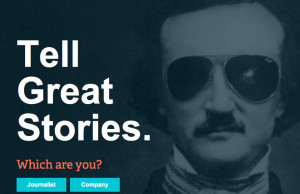
When terrorists opened fire on a crowded shopping mall in Nairobi this fall, news outlets wanted feet on the ground in Kenya fast.
Newsmodo, an Australian-based startup, quickly offered up 450 registered freelancers in the area to accept news assignments from around the world.
The online marketplace, which is designed to connect freelance journalists with publishers, was able to get work for freelancers and coverage for news outlets, said Rakhal Ebeli, Newsmodo’s founder and chief executive officer.
“Anywhere an incident unfolds these days, we’re able to find a freelancer nearby,” he said.
When it launched in April, Newsmodo joined a wave of other startups that aim to satisfy the growing demand for professional digital content by creating marketplaces for multimedia news and feature stories.
Some focus more on news content, others on marketing material, while still others blend the two and allow writers to dabble in both.
Fueling demand for freelance content, according to media experts, are at least three types of publishers–traditional newsrooms, which are downsizing and looking to fill coverage gaps; newer, niche websites popping up almost daily to cover specific topics; and corporations and nonprofits which are bypassing traditional media to promote their brands by creating digital content of their own.
Bill Momary, a former Los Angeles Times regional advertising manager who founded eByline, another freelance marketplace, said he believes freelancers will become the norm for the news industry as economic trends keep pressuring them to curb costs.
“It’s hard to see a model where it shrinks,” he said.
Steve Outing, an independent digital media consultant based in Colorado, sees demand for freelance journalism growing faster in the corporate market than in traditional news outlets, which he said are cutting freelance budgets as well as staff.
While demand for freelance journalism may be increasing, it’s unclear exactly how it will be filled. The business model for news marketplaces remains a work in progress as startups experiment with different pricing plans and ways to connect publishers and writers.
Here’s a look at strategies taken by three ventures aiming to be the go-to place on the Internet for freelancing professional content.
Newsmodo: Global Network for Freelance News
When Newsmodo launched in mid-April, it initially aimed to be a place where freelance journalists could sell their stories and multimedia content to news organizations.
Since then, the startup has evolved to serve publishers too, allowing them to post requests for specific work to potential freelancers as well as letting journalists pitch story ideas.
The initial model was challenging for freelancers because their pre-shot or pre-written work was being pitted against wire services, said Ebeli, the former television journalist who started Newsmodo.
With a model aimed at connecting publishers’ needs to available freelancers, more than 12,000 freelancers around the globe have signed up for Newsmodo, Ebeli said.
He said the most common publishers using the service are niche publications, such as a bicycling magazine, and outlets trying to cover international events that don’t have the resources to deploy their own reporter or photographer.
While the business model continues to evolve, Newsmodo acts like a broker or an agent. Freelancers pay nothing to use the service, but publishers pay fees.
Whenever a client purchases a story from a freelancer, regardless of whether the news outlet offered the assignment or the freelancer pitched it, Newsmodo typically gets a 10 to 30 percent commission from the publisher, Ebeli said.
Ebyline: A Blend of News and Marketing
Ebyline, based in Los Angeles, has its roots in the great recession that hit the newspaper industry hard in 2009, triggering widespread layoffis.
Bill Momary, who had worked for The Los Angeles Times for almost eight years, said he saw the cutbacks as an opportunity for freelancers and he launched Ebyline with a self-serve model to help publishers find professional writers and help them manage freelance projects.
Ebyline uses a strict vetting process to ensure that its freelancers are professionals who maintain high standards for quality. It has more than 3,000 contributors, and the number continues to grow, according to Momary.
Like Newsmodo, Ebyline works on commission, taking a cut from publishers who commission work from freelancers. Also like Newsmodo, it offers freelancers the ability to pitch their story ideas to editors from various publications, which include corporations.
Momary said that while he sees opportunities growing for freelancers, the rates that Ebyline’s clients pay freelancers vary based on word count and assignment difficulty.
Publishers have different demands, he added, with some small to mid-sized businesses using marketplaces which employ a less stringent vetting process among freelancers.
“There are demands for speed,” he said.
There is no rule of thumb for price, Momary added.
However, smaller publications typically pay less, while print magazines and corporate communications projects typically pay the most on a per-word basis.
Traditional outlets don’t pay as much as other publishers, he added. Nontraditional new publications that tend to pay higher rates include ones marketing companies and brands; magazines from academia, such as alumni news; as well as nonprofits and governments.
Momary said these rates could shift as the media industry is putting more focus on quality online work.
Contently: Connecting Brand Marketers and Writers
Based in New York, Contently is another digital media marketplace born during the economic slump.

Home page of Contently, an online content marketplace
It began in 2010 with a goal of amassing a wide network of freelancers in the hopes of attracting publishers in the traditional media market, such as newspapers and magazines.
But Shane Snow, Contently’s co-founder and chief creative officer, said traditional media did not offer much steady work for freelancers. “The job opportunities were pretty grim then,” he said.
Snow said there were significantly more opportunities among private companies seeking writers for branded content and native advertising, which led the company to enter the business that has come to be known “content marketing.”
Eighty percent of the freelance work now brokered by Contently is for work with brands, while the remaining 20 percent is with traditional media, he said.
Contently has 25,000 freelancers, who mostly use the website for the robust online portfolio it provides allowing them to showcase their work to potential clients.
A small subset of its freelance network — 5,000 — includes professional journalists whose credentials have been vetted, and Contently helps them find work with companies and news outlets.
Contently takes 15 percent of a paid freelancer’s commission, according to Snow.
Snow said the company wants to help strong writers; it is focused on quality content and wants to combat the image of content being used as a commodity for search engine optimization.
Snow said engagement has become a magical metric for what brands are looking for as companies increasingly seek writers who can write deep, rich content that will prompt users to share and engage with it.
He said he thinks more freelancers are pivoting towards branded content because the money is better and traditional media companies are not requesting work as consistently as corporations.
Correction: December, 5, 2013: An earlier version of this article misstated Bill Momary’s former title at the Los Angeles Times.










Leave a Comment